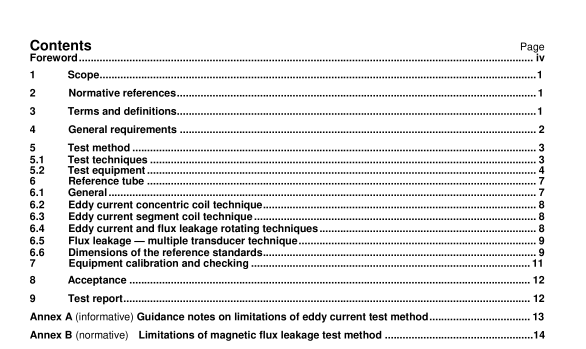ISO 10893-1 pdf download

ISO 10893-1 pdf download Non-destructive testing of steel tubes — Part 1 : Automated electromagnetic testing of seamless and welded (except submerged arc-welded) steel tubes for the verification of hydraulic leaktightness
5 Test method
5.1Test techniques
5.1.1 Depending on the type of products, the dimensions, the type of steel used and its magnetic properties, thetubes shall be tested for the verification of hydraulic leaktightness by either the eddy current method or the fluxleakage method, using one of the following automated or semi-automated techniques:
a) concentric coil technique (eddy current method) (see Figure 1);
b) segment coil technique (eddy current method) (see Figure 2);
c) fixed or rotating probe/pancake coil technique (eddy current method)(see Figure 3);d)fixed or rotating magnetic transducer technique (flux leakage method)(see Figure 4);e) multiple concentric magnetic transducers technique(flux leakage method)(see Figure 5).
For all techniques, the chosen relative speed of movement during the testing shall not vary by more than±10 %.NOTE 1 lt is recognized that there can be, as in the case of hydraulic testing under normal production conditions, a short length atboth tube ends which cannot be tested.
NOTE 2 See Annexes A and B for guidelines on the limitations of the eddy current test method and flux leakage test method.
5.1.2 When testing seamless or welded tubes using the eddy current concentric coil technique, the maximumtube outside diameter tested shall be restricted to 250 mm.
Square or rectangular tubes with a maximum dimension across the diagonal of 250 mm may also be tested usingthis technique with adequately shaped coils.
5.1.3 When testing tubes using the segment coils technique, the maximum tube outside diameter that shall betested shall be limited to:
-o219,1 mm for 2x 180° coils;-o 508,0 mm for 4 × 100° coils.
5.1.4When testing seamless or welded tubes using the fixed or rotating probe/pancake coil eddy currenttechnique or the fixed or rotating magnetic transducer fiux leakage technique, the tube and the probesipancakecoils/magnetic transducer shall be moved relative to each other or the movement shall be simulated by electroniccommutation through the individual probes composing the pancake, such that the whole of the tube surface isscanned with coverage calculated on the dimensions of probe/pancake coils and magnetic transducers. There isno restriction on the maximum outside diameter using these techniques.
5.1.5 When testing seamless and welded tubes using the multiple concentric magnetic transducer technique,the tube and the multiple transducer assembly shall be linearly moved relative to each other such that the whole ofthe tube surface is scanned with coverage calculated on the dimensions of probe/pancake coils and magnetictransducers.There is no restriction on the maximum outside diameter using this technique.
6 Reference tube6.1General
6.1.1 The reference standards defined in this part of lSO 10893 are convenient standards for the calibration ofnon-destructive testing equipment. The dimensions of these standards should not be construed as the minimumsize of imperfection detectable by such equipment.
6.1.2 The reference tubes shall have the same specified diameter and thickness, same surface finish, deliverycondition (e.g. as-rolled,normalized, quenched and tempered) and similar steel grade as the tubes under test.For specified wall thickness exceeding 10 mm, the wall thickness of the reference tubes may be greater than thespecified wall thickness of the pipe being inspected, provided the notch depth is calculated on the specified wallthickness of the pipe being inspected.The manufacturer shall demonstrate, on request, the effectiveness of theadopted solution.
6.1.3 The reference standards used for the various testing techniques shall be as follows:
a) a reference hole or holes as defined in 6.2 and 6.6.1, when using the eddy current concentric coil and asdefined in 6.3 and 6.6.1, when using segment coil technique;
b) a reference longitudinal notch, as defined in 6.4 and 6.6.2, when using one of the following techniques:
1 ) fixed or rotating probe/pancake coil eddy current technique;
2) fixed or rotating magnetic transducer flux leakage technique.
c) a reference transverse notch, as defined in 6.5 and 6.6.2, when using the multiple concentric magnetic transducer flux leakage technique;









